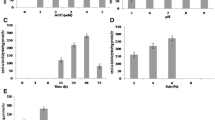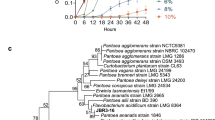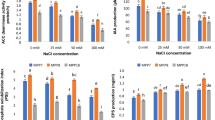Abstract
Plant growth promoting bacteria (PGPB) with 1-aminocyclopropane-1-carboxylate deaminase (ACC deaminase) activity can be used to ameliorate salt stress in plants. The aim of this study was to characterize a salt-tolerant PGP bacterium Serratia sp. SL-12 isolated from a salt lake, and to evaluate its capability to promote growth in wheat plants (Triticum aestivum L) under conditions of salt stress. The isolate SL-12 exhibited other plant growth promoting properties such as the production of indole-3-acetic acid, and enabling solubilization of inorganic phosphate. An analysis of fatty acid composition of the isolate grown at different salt concentrations (150–200 mM) indicated that salt concentration strongly influenced the fatty acid composition, and increased the proportion of unsaturated fatty acids. Inoculation of SL-12 into wheat plants growing under salt stress (150–200 mM NaCl) resulted in a significant increase in plant growth, as measured by parameters such as shoot/root length, fresh/dry weight, and photosynthetic pigment accumulation. In addition, application of isolate SL-12 decreased the levels of Na+ by (65 %) and increased the uptake of K+ by (39 %), indicating a role in maintaining ionic homeostasis, and minimizing toxic ionic effects in host wheat plants. The growth of wheat seedling under salinity stress was improved by SL-12 by inducing accumulation of osmolytes such as total soluble sugar and total protein content, while reducing the salt-induced malondialdehyde content. This has been found by other researchers. The present study indicates the potential of isolate SL-12 as a biofertilizer for enhancing the growth of wheat and other crops under salt stress conditions.


Similar content being viewed by others
References
Ahmad F, Ahmad I, Khan MS (2008) Screening of free-living rhizospheric bacteria for their multiple growth promoting activities. Microbiol 163:173–181
Allakhverdiev SI, Sakamoto A, Nishiyama Y, Inaba M, Murata N (2000) Ionic and osmotic effects of NaCl induced inactivation of photosystems I and II in Synechococcus sp. Plant Physiol 123:1047–1056
Andreae WA, Ysselstein MWH (1960) Studies on 3-indoleacetic acid metabolism VI 3-indoleacetic acid uptake and metabolism by pea roots as compared to pea epicotyls. Plant Physiol 35:225–232
Arnon DI (1949) Copper enzyme is isolated chloroplast polyphenol oxidase in Beta vulgaris. Plant Physiol 24:1–15
Bano A, Fatima M (2009) Salt tolerance in Zea mays (L.) following inoculation with Rhizobium and Pseudomonas. Biol Fert Soils 45:405–413
Bates L, Waldren RP, Teare ID (1973) Rapid determination of free proline for water-stress studies. Plant Soil 39:205–207
Belimov AA, Hontzeas N, Safronova VI, Demchinskaya SV, Piluzza G, Bullitta S, Glick BR (2005) Cadmium-tolerant plant growth promoting rhizobacteria associated with the roots of Indian mustard (Brassica juncea L. Czern.). Soil Biol Biochem 37:241–250
Bradford MM (1976) A rapid and sensitive method for the quantification of microgram quantities of protein utilizing the principle of protein–dye binding. Anal Biochem 72:248–254
Cappuccino JG, Sherman N (1992) Biochemical activities of microorganisms In: Microbiology, A Laboratory Manual. The Benjamin / Cummings Publishing Co California, USA
Castric PA (1974) Hydrogen cyanide, a secondary metabolite of Pseudomonas aeruginosa. Can J Microbiol 21:613–618
Chen Z, Pottosin II, Cuin TA, Fuglsang AT, Tester M, Jha D, Zepeda-Jazo I, Zhou M, Palmgren MG, Newman IA, Shabala S (2007) Root plasma membrane transporters controlling K+/Na+ homeostasis in salt-stressed barley. Plant Physiol 145:1714–1725
Christie WW (1993) Preparation of ester derivatives of fatty acids for chromatographic analysis. Adv Lipid Methodol 2:69–111
Connelly MB, Young GM, Sloma A (2004) Extracellular proteolytic activity plays a central role in swarming motility in Bacillus subtilis. J Bacteriol 186:4159–4167
Del Amor FM, Cuadra-Crespo P (2012) Plant growth-promoting bacteria as a tool to improve salinity tolerance in sweet pepper. Funct Plant Biol 39:82–90
Dimkpa C, Wein T, Ash F (2009a) Plant-rhizobacteria interactions alleviate abiotic stress conditions. Plant Cell Environ 32:1682–1694
Dimkpa CO, Merten D, Svatoš A, Büchel G, Kothe E (2009b) Metal-induced oxidative stress impacting plant growth in contaminated soil is alleviated by microbial siderophores. Soil Biol Biochem 41:154–162
Dobereiner J (1995) Isolation and identification of aerobic nitrogen-fixing bacteria from soil and plants. In: Alef K, Nannipieri P (eds) Methods in applied soil microbiology and biochemistry. Academic, London, pp 134–141
Dworkin M, Foster J (1958) Experiments with some microorganisms which utilize ethane and hydrogen. J Bacteriol 75:592–603
Egamberdiyeva D (2007) The effect of plant growth promoting bacteria on growth and nutrient uptake of maize in two different soils. Appl Soil Ecol 36:184–189
Egamberdiyeva D (2009) Alleviation of salt stress by plant growth regulators and IAA producing bacteria in wheat. Acta Physiol Plant 31:861–864
El-Tarabily KA (2008) Promotion of tomato (Lycopersicon esculentum Mill.) plant growth by rhizosphere competent 1-aminocyclopropane-1-carboxylic acid deaminase-producing streptomycete actinomycetes. Plant Soil 308:161–174
George P, Gupta A, Murali GM, Thomas L, Thomas GV (2012) Multifarious beneficial traits and plant growth promoting potential of Serratia marcescens KiSII and Enterobacter sp RNF 267 isolated from the rhizosphere of coconut palms (Cocos nucifera L). World J Microbiol Biotechnol 29:109–117
Glick BR (2004) Bacterial ACC deaminase and the alleviation of plant stress. Adv Appl Microbiol 56:291–312
Glick BR (2007) Promotion of plant growth by bacterial ACC deaminase. Crit Rev Plant Sci 26:227–242
Gordon SA, Weber RP (1951) Colorimetric estimation of indole acetic acid. Plant Physiol 26:192–195
Gupta B, Huang B (2014) Mechanism of salinity tolerance in plants: physiological, biochemical, and molecular characterization. Int J Genomics 2014:701596
Han HS and Lee KD (2005) Plant growth promoting rhizobacteria effect on antioxidant status, photosynthesis, mineral uptake and growth of lettuce under soil salinity. Res J Agr Biological Sci 1:210–215
Han QQ, Lü XP, Bai JP, Qiao Y, Paré PW, Wang SM (2014) Beneficial soil bacterium Bacillus subtilis (GB03) augments salt tolerance of white clover. Front Plant Sci 5:525. doi:10.3389/fpls201400525
Harley JP, Prescott LM (2002) Laboratory exercises in microbiology, 5th edn. McGraw-Hill Companies, Texas
Hoagland DR, Boyer TC (1936) General nature and process of salt accumulation by roots with description of experimental methods. Plant Physiol 11:471–507
Hodges DM, Delong JM, Forney CF, Prange RK (1999) Improving the thiobarbituric acid reactive substances assay for estimating lipid peroxidation in plant tissue containing anthocyanin and other interfering compounds. Planta 207:604–611
Irogoyen JJ, Einerich DW, Sanchez-Diaz M (1992) Water stress induced changes in concentrations of proline and total soluble sugars in nodulated alfalfa (Medicago sativd) plants. Plant Physiol 84:55–60
Jha CK, Annapurna K, Saraf M (2012) Isolation of Rhizobacteria from Jatropha curcas and characterization of produced ACC deaminase. J Basic Microbiol 52:85–95
Kasana R, Salwan R, Dhar H, Dutt S, Gulati A (2008) A rapid and easy method for the detection of microbial cellulases on agar plates using Gram’s iodine. Curr Microbiol 57:503–507
Khan MA, Shirazi MU, Muhammad AK, Mujtaba SM, Islam E, Mumtaz S, Shereen A, Ansari RU, Afhraf Y (2009) Role of proline, K/Na ratio and chlorophyll content in salt tolerance of wheat (Triticum aestivum L.). Pak J Bot 41:633–638
Kumar RS, Ayyadurai N, Pandiaraja P, Reddy AV, Venkateswarlu Y, Prakash O, Sakthivel N (2005) Characterization of antifungal metabolite produced by a new strain Pseudomonas aeruginosa PUPa3 that exhibits broadspectrum antifungal activity and biofertilizing traits. J Appl Microbiol 98:145–154
Lowry OH, Rosebrough NJ, Farr AL, Randall RJ (1951) Protein measurement with the Folin phenol reagent. J Biol Chem 193:265–275
Marinetti GV (1962) Chromatographic separation: identification and analysis of phospholipids. J Lipid Res 3:1–20
Mayak S, Tirosh T, Glick BR (2004) Plant growth-promoting bacteria confer resistance in tomato plants to salt stress. Plant Physiol Biochem 42:565–572
Mehmood Z, Ahmad I, Mohammad F, Ahma S (1999) Indian medicinal plants: a potential source of anticandidal drug. Pharm Biol 37:237–242
Mehta S, Nautiyal CS (2001) An efficient method for qualitative screening of Phosphate-solubilizing bacteria. Microbiol 43:51–56
Morgan PW, Drew MC (1997) Ethylene and plant responses to stress. Physiol Plant 100:620–630
Nadeem SM, Ahmadb M, Zahir ZA, Javaid A, Ashraf M (2014) The role of mycorrhizae and plant growth promoting rhizobacteria (PGPR) in improving crop productivity under stressful environments. Biotechnol Adv 32:429–448
Naqvi SSM (1999) In: Pessarakli M (ed) Plant hormones and stress phenomena in handbook of plant and crop stress. Marcel Dekker, Inc, New York, pp 709–730
Nautiyal CS, Srivastava S, Chauhan PS, Seem K, Mishra A, Sopor SK (2013) Plant growth-promoting bacteria Bacillus amyloliquefaciens NBRISN13 modulates gene expression profile of leaf and rhizosphere community in rice during salt stress. Plant Physiol Biochem 66:1–9
Parida AK, Das AB (2005) Salt tolerance and salinity effects on plants: a review. Ecotoxicol Environ Saf 60:324–349
Pathak PS (2000) Agroforestry: a tool for arresting land degradation. Indian Farming 49:15–19
Penrose DM, Glick BR (2003) Methods for isolating and characterizing ACC deaminase containing plant growth-promoting rhizobacteria. Physiol Plant 118:10–15
Reinhold-Hurek B, Hurek T (1998) Interactions of gramineous plants with Azoarcus spp. and other diazotrophs: identification, localization, and perspectives to study their function. Crit Rev Plant Sci 17:29–54
Roy SJ, Negrao S, Tester M (2014) Salt resistant crop plants. Curr Opin Biotechnol 26:115–124
Ruffino A, Rosa M, Hilal M, González J, Prado F (2010) The role of cotyledon metabolism in the establishment of quinoa (Chenopodium quinoa) seedlings growing under salinity. Plant Soil 326:213–224
Russell NJ (1989) Adaptive modifications in membranes of halotolerant and halophilic microorganisms. J Bioenerg Biomembr 21:93–113
Saleh SS, Glick BR (2001) Involvement of gasS and pros in enhancement of the plant growth-promoting capabilities of Enterobacter cloacae CAL2 and UW4. Can J Microbiol 47:698–705
Sarkar S, Sreekanth B, Kant S, Banerjee R, Bhattacharyya BC (1998) Production and optimization of microbial lipase. Bioprocess Eng 19:29–32
Schwyn B, Neilands JB (1987) Universal chemical assay for the detection and determination of siderophores. Anal Biochem 160:47–56
Singh RP, Jha P, Jha PN (2015) The plant growth promoting bacterium Klebsiella sp. SBP-8 confers induced systemic tolerance in wheat (Triticum aestivum) under salt stress. J Plant Physiol 184:57–67
Tamura K, Stecher G, Peterson D, Filipski A, Kumar S (2013) MEGA6: molecular evolutionary genetics analysis version 60. Mol Biol Evol 30:2725–2729
Wang XL (2008) Study on liquid fermentation technology of Bacillus B579 and its living preparation Dissertation, Tianjin University of Science and Technology (in Chinese)
Yao LX, Wu ZS, Zheng YY, Kaleem I, Li C (2010) Growth promotion and protection against salt stress by Pseudomonas putida Rs-198 on cotton. Eur J Soil Biol 46:49–54
Zahir ZA, Ghani U, Naveed M, Nadeem SM, Asghar HN (2009) Comparative effectiveness of Pseudomonas and Serratia sp containing ACC-deaminase for improving growth and yield of wheat (Triticum aestivum L) under salt-stressed conditions. Archives Microbiol 191:415–424
Zhang JL, Shi H (2013) Physiological and molecular mechanisms of plant salt tolerance. Photosynth Res 115:1–22
Acknowledgments
This research was financially supported by supported by Department of Biotechnology (File No. BT/PR14527/AGR/21/326/2010), Government of India, New Delhi to PNJ. The authors are thankful to Mr. Manoj Kannan, Lecturer, Biological Sciences Department, BITS Pilani for providing editorial and language assistance..
Author information
Authors and Affiliations
Corresponding author
Ethics declarations
Conflict of interest
There is no conflict of interest in this work.
Electronic supplementary material
Below is the link to the electronic supplementary material.
Suppl. Fig. 1
(DOCX 68.9 kb)
Suppl. Fig. 2
(DOCX 13.4 kb)
Suppl. Fig. 3
(DOCX 471 kb)
Suppl. Table 1
(DOCX 12 kb)
Suppl. Table 2
(DOCX 11.6 kb)
Suppl. Table 3
(DOCX 16 kb)
Rights and permissions
About this article
Cite this article
Singh, R.P., Jha, P.N. Alleviation of salinity-induced damage on wheat plant by an ACC deaminase-producing halophilic bacterium Serratia sp. SL- 12 isolated from a salt lake. Symbiosis 69, 101–111 (2016). https://doi.org/10.1007/s13199-016-0387-x
Received:
Accepted:
Published:
Issue Date:
DOI: https://doi.org/10.1007/s13199-016-0387-x




